The desert pipistrelle is a species of vesper bat in the genus Hypsugo. It is found in Egypt, Israel, Jordan, Oman, Saudi Arabia, Sudan, and Yemen. Some of the Arabian populations were previously regarded as a separate species, Hypsugo bodenheimeri, but the proposed differences between the two do not hold. Its natural habitats are subtropical or tropical dry shrubland, rocky areas, and hot deserts.

Goldman's woodrat is a rodent species in the family Cricetidae. It is found only in Mexico throughout the Mexican Plateau, stretching from Southeast Chihuahua to South San Luis Potosi and North Queretaro. The plateau is an average 5,988 ft. above sea level and covers a land area of 232,388 sq. miles.
Barbour's rock mouse is a species of rodent in the family Nesomyidae. It is found only in South Africa. Its natural habitats are subtropical or tropical dry shrubland and rocky areas. It is threatened by habitat loss.
The Bolivian chinchilla rat is a species of chinchilla rat in the family Abrocomidae. It is found only in Manuel María Caballero Province, Bolivia. Its natural habitat is the rocky areas of cloud forests in Bolivia's interior.
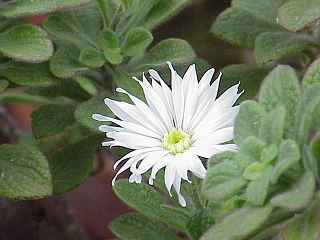
Commidendrum rugosum, known as scrubwood, is a species of flowering plant in the family Asteraceae.

Leucheria suaveolens, the vanilla daisy, is a species of flowering plant in the family Asteraceae. It is endemic to Falkland Islands. Its natural habitats are temperate shrubland, rocky areas, and rocky shores. It is threatened by habitat loss.
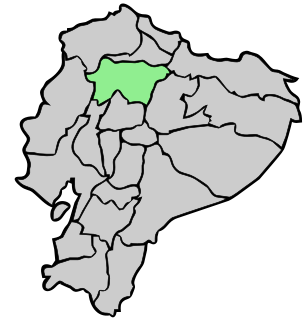
Senecio antisanae is a species of Senecio in the aster family found only in the subtropical or tropical moist montane region of Ecuador. It is threatened by habitat loss.

Senecio iscoensis or Aetheolaena senecioides is a flowering plant in the aster family. It is found only in subtropical and tropical dry shrubland in Ecuador. It is threatened by habitat loss.
Senecio lamarckianus, the bois de chèvre, is a species of flowering plant in the aster family and a member of the genus Senecio. It is endemic to the island of Mauritius and is threatened by habitat loss.
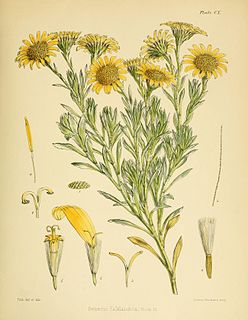
Senecio littoralis, the woolly ragwort, is a species of flowering plant in the aster family. It is endemic to the Falkland Islands. Its natural habitats are temperate shrubland, rocky areas, and rocky shores. This species is threatened by habitat loss.
The Broadley's ridged frog is a species of frog in the family Ptychadenidae. It is endemic to Malawi.
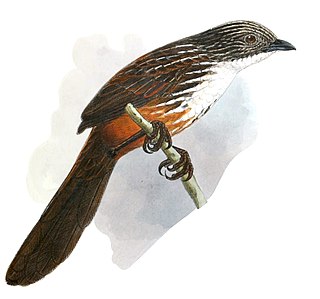
The white-throated grasswren is a species of bird in the family Maluridae. It is endemic to Australia.
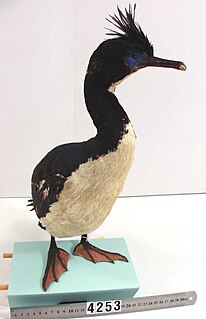
The Bounty shag, also known as the Bounty Island shag, is a species of cormorant of the family Phalacrocoracidae. They are found only on the tiny and remote Subantarctic Bounty Islands, 670 km southeast of New Zealand. Its natural habitats are open seas and rocky shores. In 2005 618 individuals were counted and the population seems to have remained stable since.

The Makwassie musk shrew is a species of mammal in the family Soricidae. It is found in South Africa, Eswatini, and Zimbabwe. Its natural habitat is rocky areas.

The Saharan shrew is a species of mammal in the family Soricidae. It is found in Mauritania and Morocco. Its natural habitats are rocky areas and sandy shores. It is threatened by habitat loss.

The East African epauletted fruit bat is a species of megabat in the family Pteropodidae. It is found in Ethiopia, Kenya, Somalia, Tanzania, and Uganda. Its natural habitats are dry savanna and rocky areas. It is threatened by habitat loss.
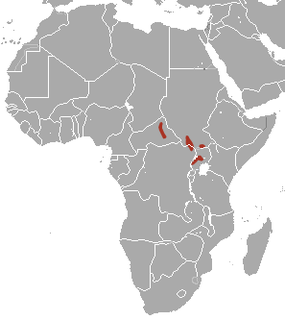
The Bunyoro rabbit or Central African rabbit is a species of mammal in the family Leporidae. It is monotypic within the genus Poelagus. It is found in central Africa and its typical habitat is damp savannah, often with rocky outcrops.
Aitchisoniella himalayensis is a species of liverwort in the family Exormothecaceae. Its natural habitats are rocky areas and cold desert of Sichuan and Himachal Pradesh. It is threatened by habitat loss.

The jackass shrew is a species of mammal belonging to the Soricidae family. It is endemic to Turkey. Its natural habitat is in rocky areas.
Senecio cadiscus is a species of aquatic flowering plant in the aster family, Asteraceae. It is endemic to the Western Cape of South Africa, where it grows in vernal pools. It was at one time classified as Cadiscus aquaticus, the only species in the monotypic genus Cadiscus, but molecular phylogenetic analysis showed that it is nested within Senecio. It is a floating or emergent plant with small narrow leaves and white-rayed flowers. Its populations are small and fragmented, and are declining. The plant is threatened by grazing and trampling by livestock, invasive plants, reclamation of wetlands and eutrophication from fertilizer runoff. The International Union for Conservation of Nature has consequently rated it as "critically endangered".













